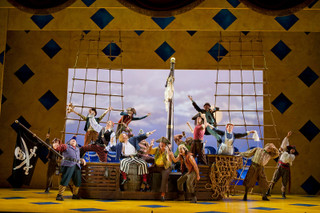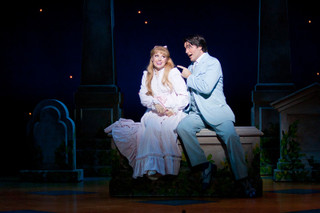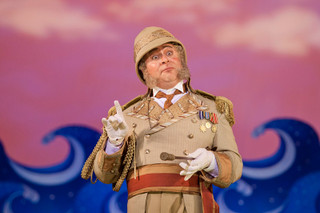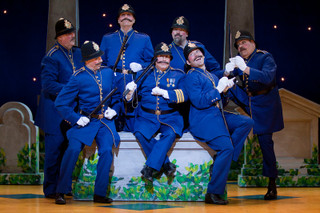|
Back
Playful pirating San Diego
Civic Theater
10/14/2017 - & October 17, 20, 22, 2017
Sir William Schwenck Gilbert & Sir Arthur Seymour Sullivan: The Pirates of Penzance
Maureen McKay (Mabel), Mackenzie Whitney (Frederic), Greer Grimsley (The Pirate King), Patrick Carfizzi (Major-General Stanley), Michael Sokol (Sergeant of Police), Luretta Bybee (Ruth), Ted Pickell (Samuel), Tasha Koontz (Edith), Sarah-Nicole Carter (Kate), Patricia McAfee (Isabel)
San Diego Opera Chorus, Bruce Stasyna (chorus master), San Diego Symphony Orchestra, Jeff Thayer (concertmaster), Evan Rogister (conductor)
Séan Curran (stage director), James Schuette (set and costume designer), Robert Wierzel (lighting designer), Steven W. Bryant (wig and make-up designer) 
(© J. Katarzyna Woronowicz Johnson)
After a powerful Salome in 2012, Séan Curran returns to San Diego Opera (SDO) to give his nautical take on this colorfully Vaudevillian James Schuette depiction of The Pirates of Penzance. While a Gilbert and Sullivan execution comes with its own set of deft commands, it challenges by way of balancing outrageous camp and tickles of realistic accommodation. Certainly, SDO makes judicious attempts to course the Cornish coastline with absurdity, but rocky seas are encountered. Because of weighty parleys, voice projection tests song and dialogue. This becomes the production challenge, and even though mics deliver sound enrichment, attempts are inconsistent.
Luretta Bybee, perfectly cast as the auditory-deficient Ruth, is the first of a running parade of characters to cross center stage: theatrically, her patrols as Frederic’s guardian create matronly impressions, yet her “When Fred’ric was a little lad” is muddied (Sullivan’s low notes) inside a dominating Evan Rogister swell (which repeats itself numerous times, particularly with Tasha Koontz’s Edith and Sarah-Nicole Carter’s Kate.)
On the opposite end of the spectrum, SDO’s préféré bass-baritone, Greer Grimsley, dynamically announces himself as Penzance’s Pirate King, yet self-dilutes inside “Oh, better far to live and die” with an unfruitful finish. [The “Paradox Trio” (along with Whitney’s Frederic) is penetrating and feigned with choral, choreographed delight!]

M. McKay, M. Whitney (© J. Katarzyna Woronowicz Johnson)
Continuing on the same path, debuting Mackenzie Whitney, overall, yields grand returns, despite acting accessing heavier camp. Having attained percolated prominence from the earlier Falstaff, returning Maureen McKay pleasingly renditions as the swooning Mabel; however, her strength lies inside moments of softer musical equations. Thus, we have a most tender, melodic moment during the amorous repose, “Oh, here is love, here is truth” in concert with Mr. Whitney’s Frederic.

P. Carfizzi (© J. Katarzyna Woronowicz Johnson)
The audibility alongside Mr. Grimsley stems from Patrick Carfizzi’s Major-General Stanley. Enveloped in one of Mr. Schuette’s brilliant turn-of-the-century British couture, this Chitty Chitty Bang Bang Lionel Jeffries look-alike makes for a marvelously humorous “orphaned” father who gets a bit sidetracked inside Maestro Rogister’s dizzying “I am the very model of a modern Major-General” (note: the encore rendition lands the singer, alas, more disjointedness.) In contrast, where we find angelic delight is grooved inside his Act II Schubertian aria, “Softly sighing to the river.”

M. Sokol (© J. Katarzyna Woronowicz Johnson)
If there’s stability within the argument of “balance”, it originates from Michael Sokol as the Sergeant of Police. He’s the “diplomacy of proper Sullivan decorum” when positioned inside this Penzance: never overdone, forthright, true-to-form, and grounded. This is where we find SDO’s men’s chorus taking the crown during “A policemen’s lot is not a happy one.” The Séan Curran blocking is simple and effective while maintaining humorous aspects without indulgences.
Chorally, Bruce Stasyna triumphs once again. There is an assiduous blend of voices and the projection is pleasing but not overpowering. One of the reasons to react in choreographic “hiccups” is the unimpressive footwork during several of the men’s (specifically pirates’) numbers: the imagination is wane. Overall, group numbers merit a “second look”, as they logically deserve a crisper formulation. In summary, snappy and punctilious positioning could reap grander benefits.
Christie Grimstad
|